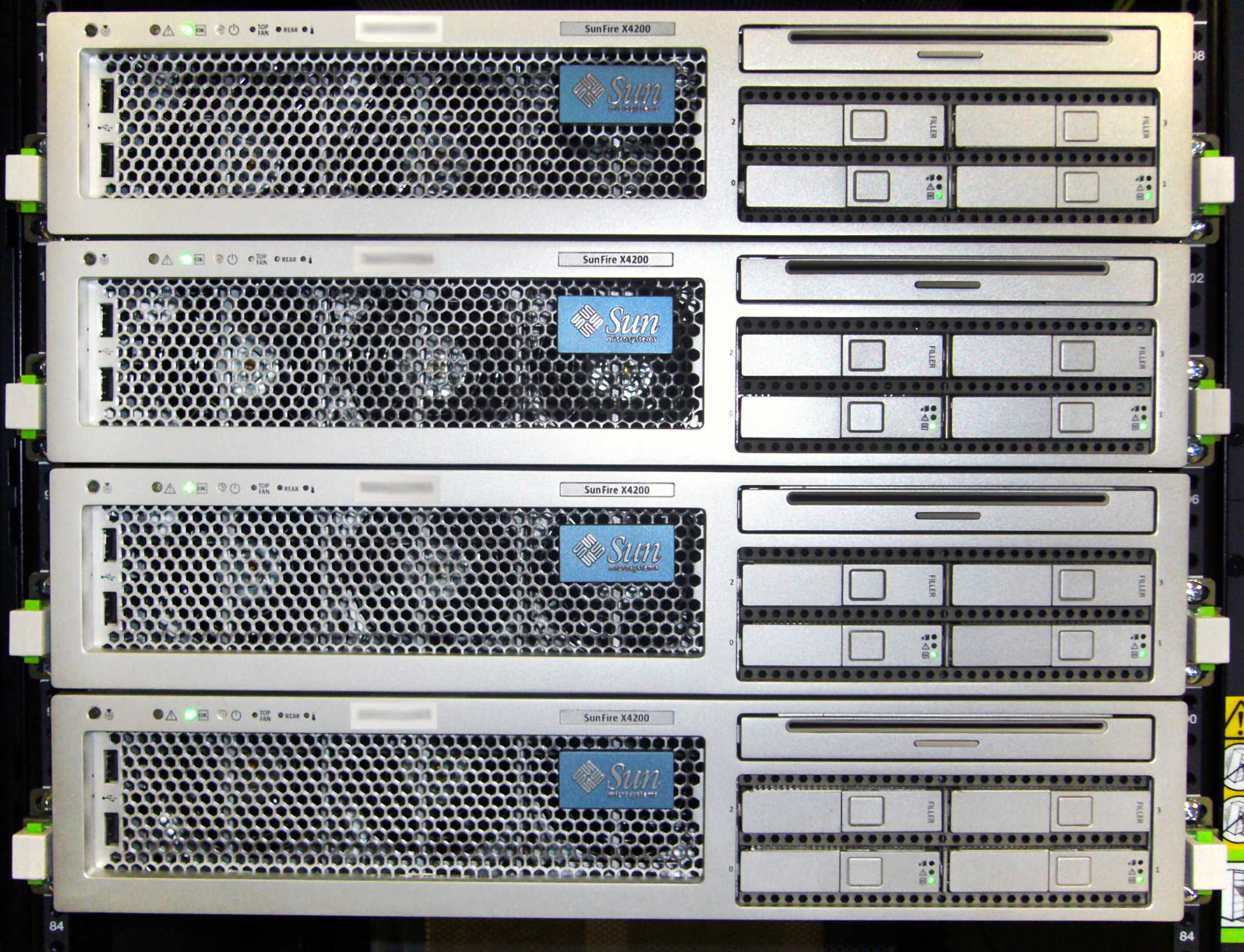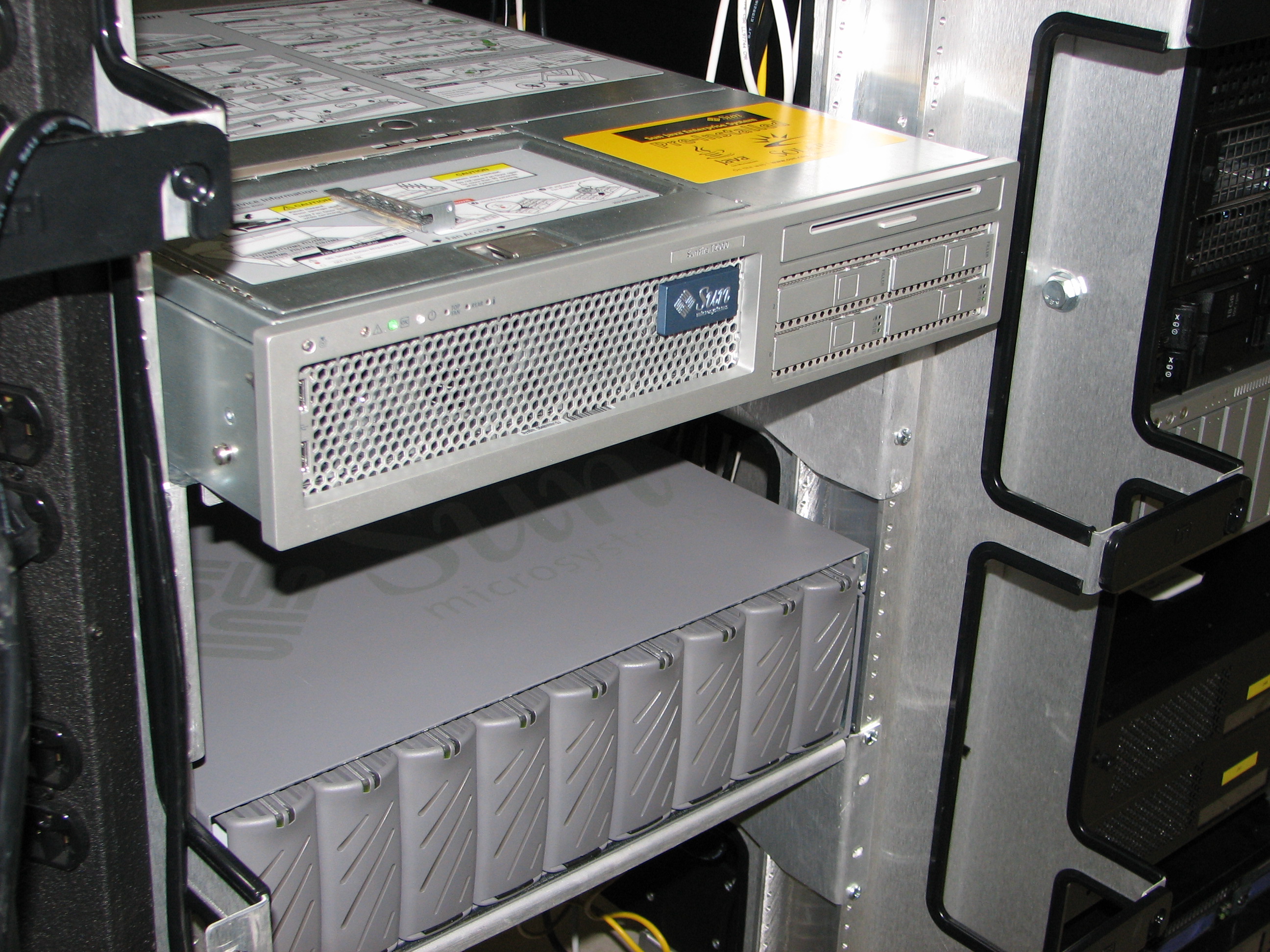sun fire on:
[Wikipedia]
[Google]
[Amazon]


 Sun Fire is a series of server computers introduced in 2001 by
Sun Fire is a series of server computers introduced in 2001 by

 Later Sun Fire model numbers have prefixes indicating the type of system, thus:
* V: entry level and mid-range rackmount and cabinet servers (UltraSPARC, IA-32 or AMD64)
* E: high-end enterprise class cabinet servers with high-availability features (UltraSPARC)
* B:
Later Sun Fire model numbers have prefixes indicating the type of system, thus:
* V: entry level and mid-range rackmount and cabinet servers (UltraSPARC, IA-32 or AMD64)
* E: high-end enterprise class cabinet servers with high-availability features (UltraSPARC)
* B:

Sun System Handbook, Version 2.1.8, April 2005
Sun Servers
Sun Microsystems
{{Oracle Fire Oracle hardware Computer-related introductions in 2001 SPARC microprocessor products


 Sun Fire is a series of server computers introduced in 2001 by
Sun Fire is a series of server computers introduced in 2001 by Sun Microsystems
Sun Microsystems, Inc. (Sun for short) was an American technology company that sold computers, computer components, software, and information technology services and created the Java programming language, the Solaris operating system, ZFS, the ...
(since 2010, part of Oracle Corporation
Oracle Corporation is an American multinational computer technology corporation headquartered in Austin, Texas. In 2020, Oracle was the third-largest software company in the world by revenue and market capitalization. The company sells da ...
). The Sun Fire branding coincided with the introduction of the UltraSPARC III
The UltraSPARC III, code-named "Cheetah", is a microprocessor that implements the SPARC, SPARC V9 instruction set architecture (ISA) developed by Sun Microsystems and fabricated by Texas Instruments. It was introduced in 2001 and operates at 600 ...
processor, superseding the UltraSPARC II-based Sun Enterprise
Sun Enterprise is a range of UNIX server computers produced by Sun Microsystems from 1996 to 2001. The line was launched as the Sun Ultra Enterprise series; the ''Ultra'' prefix was dropped around 1998. These systems are based on the 64-bit Ult ...
series. In 2003, Sun broadened the Sun Fire brand, introducing Sun Fire servers using the Intel Xeon processor. In 2004, these early Intel Xeon models were superseded by models powered by AMD Opteron processors. Also in 2004, Sun introduced Sun Fire servers powered by the UltraSPARC IV dual-core processor. In 2007, Sun again introduced Intel Xeon Sun Fire servers, while continuing to offer the AMD Opteron versions as well.
SPARC-based Sun Fire systems were produced until 2010, while x86-64 based machines were marketed until mid-2012. In mid-2012, Oracle Corporation ceased to use the Sun Fire brand for new server models.
Operating systems
UltraSPARC-based Sun Fire models are licensed to run the Solaris operating system versions 8, 9, and 10. Although not officially supported, some Linux versions are also available from third parties, as well asOpenBSD
OpenBSD is a security-focused, free and open-source, Unix-like operating system based on the Berkeley Software Distribution (BSD). Theo de Raadt created OpenBSD in 1995 by forking NetBSD 1.0. According to the website, the OpenBSD project em ...
and NetBSD
NetBSD is a free and open-source Unix operating system based on the Berkeley Software Distribution (BSD). It was the first open-source BSD descendant officially released after 386BSD was forked. It continues to be actively developed and is a ...
.
Intel Xeon and AMD Opteron based Sun Fire servers support Solaris 9 and 10, OpenBSD
OpenBSD is a security-focused, free and open-source, Unix-like operating system based on the Berkeley Software Distribution (BSD). Theo de Raadt created OpenBSD in 1995 by forking NetBSD 1.0. According to the website, the OpenBSD project em ...
, Red Hat Enterprise Linux versions 3 - 6, SUSE Linux Enterprise Server
SUSE Linux Enterprise (often abbreviated to SLE) is a Linux-based operating system developed by SUSE. It is available in two editions, suffixed with Server (SLES) for servers and mainframes, and Desktop (SLED) for workstations and desktop compu ...
10 and 11, Windows 2000, Windows Server 2003, 2008
File:2008 Events Collage.png, From left, clockwise: Lehman Brothers went bankrupt following the Subprime mortgage crisis; Cyclone Nargis killed more than 138,000 in Myanmar; A scene from the opening ceremony of the 2008 Summer Olympics in Beijing; ...
, and 2008 R2 .
Model nomenclature
 Later Sun Fire model numbers have prefixes indicating the type of system, thus:
* V: entry level and mid-range rackmount and cabinet servers (UltraSPARC, IA-32 or AMD64)
* E: high-end enterprise class cabinet servers with high-availability features (UltraSPARC)
* B:
Later Sun Fire model numbers have prefixes indicating the type of system, thus:
* V: entry level and mid-range rackmount and cabinet servers (UltraSPARC, IA-32 or AMD64)
* E: high-end enterprise class cabinet servers with high-availability features (UltraSPARC)
* B: blade server
A blade server is a stripped-down server computer with a modular design optimized to minimize the use of physical space and energy. Blade servers have many components removed to save space, minimize power consumption and other considerations, whil ...
s (UltraSPARC or IA-32)
* X: rackmount x86-64 based servers
* T: entry level and mid-range rackmount servers based on UltraSPARC T-series ''CoolThreads'' processors
When Sun offered Intel Xeon and AMD Opteron Sun Fire servers under the V-Series sub brand, Sun used an x suffix to denote Intel Xeon processor based systems and a z suffix for AMD Opteron processor based systems, but this convention was later dropped. The z suffix was also used previously to differentiate the V880z Visualization Server variant of the V880 server.
Sun's first-generation blade server
A blade server is a stripped-down server computer with a modular design optimized to minimize the use of physical space and energy. Blade servers have many components removed to save space, minimize power consumption and other considerations, whil ...
platform, the Sun Fire B1600 chassis and associated blade servers, was branded under the Sun Fire server brand. Later Sun blade systems were sold under the Sun Blade brand.
In 2007, Sun, Fujitsu
is a Japanese multinational information and communications technology equipment and services corporation, established in 1935 and headquartered in Tokyo. Fujitsu is the world's sixth-largest IT services provider by annual revenue, and the la ...
and Fujitsu Siemens introduced the common SPARC Enterprise brand for server products. The first SPARC Enterprise models were the Fujitsu-developed successors to the midrange and high-end Sun Fire E-series. In addition, the Sun Fire T1000 and T2000 servers were rebranded as the SPARC Enterprise T1000 and T2000 and sold under the Fujitsu brands, although Sun continued to offer these with their original names. Later T-series servers have also been badged SPARC Enterprise rather than Sun Fire.
Since late 2010, Oracle Corporation
Oracle Corporation is an American multinational computer technology corporation headquartered in Austin, Texas. In 2020, Oracle was the third-largest software company in the world by revenue and market capitalization. The company sells da ...
no longer uses Sun Fire brand for their current T series SPARC servers, and since mid-2012 for new X series x86-64 machines based on Intel Xeon CPUs. x86-64 server models which had been developed by Sun Microsystems before its acquisition, and were still in production, have all been rebranded as Sun Server X-series.
Sun Fire model range
Some servers were produced in two versions, the original version and a later RoHS version. Since a general maintenance and upgrade guideline is that RoHS components and spares may be installed into the original non-RoHS versions of that server, the end-of-life (EOL) date of a server is deemed the EOL date of the RoHS version of that server in this listing.UltraSPARC architecture

x86/x64 architecture
Sun Server / Oracle Server
As of 2012, the x86 server range continued under the "Sun Server" or "Oracle Server" names.See also
* FireplaneReferences
Sun System Handbook, Version 2.1.8, April 2005
External links
Sun Servers
Sun Microsystems
{{Oracle Fire Oracle hardware Computer-related introductions in 2001 SPARC microprocessor products